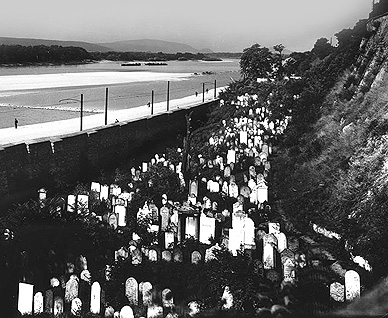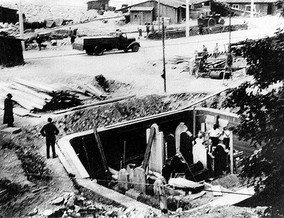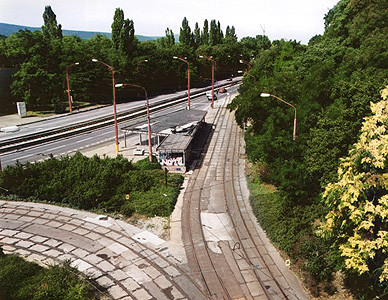This first cemetery was located at the foot of the castle hill, along the banks of the Danube, and was operational from 1696-1847. By 1847, the cemetery contained over 6000 graves, and it had became so crowded that bodies had to be buried directly on top of each other. There were three layers of bodies buried within it (looking not unlike Prague's jam-packed Jewish cemetery). With the cemetery's close proximity to the Danube, flooding was an ongoing problem as well. In 1847, a larger plot of land just up the hill was given to the Jewish community for a new cemetery. Jews were buried only in this new cemetery from that point on. That is the cemetery that Terezia and I explored back in March.
 |
| Bratislava's old Jewish cemetery. Notice the Danube in the background. |
The old cemetery was of obvious historical importance, but its status was elevated by the fact that it contained the graves of several hugely important figures, most notably an Orthodox rabbi called Chatam Sofer. Sofer had a monumental impact on Orthodox Judaism, and he lived and worked in Bratislava for over thirty years, until his death in the 1830s.
At any rate, in late 1942, around the height of Jewish persecution in Slovakia during WWII, the city decided it needed to run a major highway along the right bank of the Danube, as well as a tunnel through the adjacent castle hill, that would spill out right into the cemetery. Given that the cemetery was directly in its path, and given that Slovakia was at that time governed by an anti-semitic, Nazi-puppet regime, they simply built the road right over it. However, the Jewish community somehow managed to convince the regime to let them preserve a cluster of twenty three graves in a corner of the cemetery. These were of great significance to the local community since they included the graves of Sofer and several other important rabbis. Many other graves were apparently exhumed and relocated in the newer cemetery.
 |
| Workers exhuming graves that were to be relocated in the newer cemetery up the hill. |
 |
| The original make-shift mausoleum for Sofer et al. before the road was laid on top of it. |
 |
| Compare this 80s-era shot with the first photo up above, taken from about the same vantage point. |
Check out this cool 4 1/2 minute video I found that documents through a series of chronological photos the old cemetery, from its pre-destruction years up through the new and improved mausoleum sight:
It's obviously quite sad that a cemetery filled with so much history was destroyed. Prague, to name one example, is mighty lucky that its Jewish cemetery didn't meet a similar fate. It's just one more way in which the history of not just Bratislava's Jewish community, but the history of the city as a whole, was wiped out.
I know, you've heard enough of my whining about the rampant destruction that Bratislava's historical section suffered throughout the 20th century. But damn, this city would look so much nicer had its officials and planners felt like preserving more of it (or if they'd at least introduced new development in a more sensitive and thoughtful way). And the fact that the history and heritage of a once-thriving Jewish community was almost completely obliterated in the process, makes it all the more depressing. Tourists who come to Bratislava today are only seeing a fraction of what this city used to be, and they're getting an incomplete picture of its history.
(Hey! Click here to see the full set of Bratislava cemetery photos!)


Jeff --
ReplyDeleteWOW, thanks for this enlightening account which adds YET ANOTHER amazing dimension to the process of Bratislava's history.
While I agree completely that the history of Bratislava's Jewish community is, at least in the 20th century, a horror and a shame for all involved, I am inspired by the community's success in preserving (under a manhole, under tram tracks no less!) some small piece of the cemetery against all odds and all monstrosity. HOWEVER, I must say I believe that THIS STORY (and the current state of the graves, and the history of how they became that way, as we read it in your photos & the current layout of the site) tells us a stark and unambiguous story itself -- and IF the fascist (and later communist) city planners had been smart enough to respect the site (and preserve it), it would in effect not tell such a clear story of the loss and genocide of their era. Given the events of the 20th century, sometimes I feel like the best possible monument would be something like this, making every student of history crawl through a dark manhole between rushing trams to glimpse a shattered gravestone.
Would you mind if I used some of this material in a background comic strip around my own discoveries? I spent some time wandering this area looking for the old cemetery & had little luck. Now I know why!
Marek - by all means, feel free to use whatever you'd like as background for your comics.
DeleteYes, I suppose one could say that the history and tragic fate of the Jewish cemetery and neighborhood in Bratislava provides a stark and brutally honest picture of the loss and genocide that occurred. We tend to think of the holocaust in abstract terms - numbers so enormous that's they're nearly impossible to really fathom. But Bratislava's Jewish history, or rather, the relative lack of its physical traces, allows people to really see just how destructive the fascist and communist regimes were, because there's so little left to see. I've read that the Jewish quarter in Warsaw was largely rebuilt, and I know that a fair amount of the Jewish quarter in Prague has been lovingly preserved. But if one were to attempt that in Bratislava, it would require the demolition and rerouting of a major highway. The problem, of course, is most tourists who pass through would have very little idea about what happened and how much was destroyed unless they visited the Jewish museum.
The Chatam Sofer mausoleum can be difficult to spot since it's in such a strange place. Even the newer cemetery that's further up the hill is difficult to spot from he road since it's on the other side of a massive wall with zero signage to indicate that it's there.
I think I understand why the community might want to keep a low profile with the new cemetery.
DeleteWell, yeah, given the history of their cemeteries and neighborhoods being dug up and paved over... But also, I have read of problems with vandalism in other Jewish cemeteries, particularly out in the east, in and near Kosice, which is likely another reason for keeping a low profile.
Delete